It was lovely to return to Beale Garden. I entered at night for the second time, at around 8:30 p.m. The cicadas were unusually quiet, replaced by some very confident crickets with something very important to say, though I couldn’t tell you what it was. To my west and to my north, I heard two little frogs, cheerfully hopping on leaf-covered ground. The leaves made a soft thud as they tumble to the earth, heavy from rain. Artificial light softly illuminated the patch of grass across the creek from me, and the ground in front of me sparkled with dew against my flashlight as I wrote. A slight, cool breeze tickled my hands and face, and I was at ease.
All three of my followed objects were doing quite well when I visited. The Ribbon Redbud, as I have named it, had lost almost all its leaves! All that’s left were yellow stragglers hanging on for dear life as their brown, withered counterparts slumped lifelessly on the branch next to them. I wonder when the brown leaves will fall off- I didn’t see many on the ground. The ground still had a thick layer pine needles, but they were so thoroughly covered in maple leaves that you’d have to be looking for them to know they’re there. A few red bud leaves joined the maples in their attempt to reclaim the patch of grass, but it seems that most of them were washed away by the creek before they had the chance to join the fight.
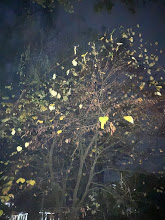
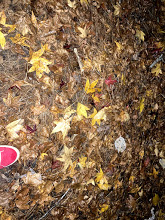
When I looked for the ants, they had disappeared from the ground! I could not find a single one anywhere, until I looked on the Norway Maple tree- more on that later. They seem to have migrated to the tree, assumedly to escape the wet soil. Maybe instead they’re a different subtype of black ant that always lives in trees, while the ground ants stay in the soil. I wish I could get a good enough picture to identify and compare them.
In my last blog, I named three species: the Eastern Redbud, the Norway Maple, and the Long-Stalked Sedge. The Redbud is doing well- it is the same Ribbon Redbud that I mentioned in this blog. The Long-Stalked Sedge is exactly the same as before, just a little older and a little wetter. The Norway Maple, however, captured my interest.

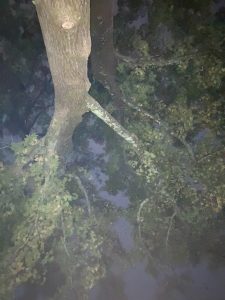
For 15 minutes, I focused on this tree, which took up about one square meter with its three thick trunks. Pointy and curved bits of bark extended across the tree in vertical spirals, and all three trunks meet to create one large base for the tree. Leaves collect in the space between trunks, and I am reminded of a bowl or dinner table for small woodland creatures that I would have read about as a child.
The first trunk stood tall and straight, its white-capped pieces of bark warmed under a small blanket of moss. At first glance the trunk appeared plain, but when I looked closer I found centipedes and a pillbug taking shelter underneath the protruding bark. The second trunk was much more alive, stretching slightly sideways as it is embraced by a thick layer of moss. In between these shelves of moss and bark, I found the ants that I had been looking for on the ground! They were smaller than I remembered, which made me wonder if they were a different subtype of black ant than the ones I’ve been observing. They clambered hastily around the bark the way we would rush through a train station. I wonder if they were gathering the moss to eat, or if they were there for some other purpose. Some of the ants ventured all the way to the third trunk, which was plain and white-capped and moss-less, only to find that they were the only creatures there. I assume they headed home after that, but my 15 minutes ran out before I got to see them go.
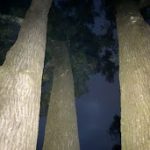

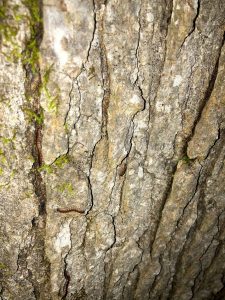
For the last five minutes of my observation time, I sat quietly and appreciated the familiar life around me as the crickets chirped on and the frogs continued to hop. Then, at around 9:30 p.m., I went home more centered than when I came.

That’s interesting, I never really thought about if ants came out during the night because they always seemed like day creatures
I enjoyed your blog post Marina – you had some good observations!